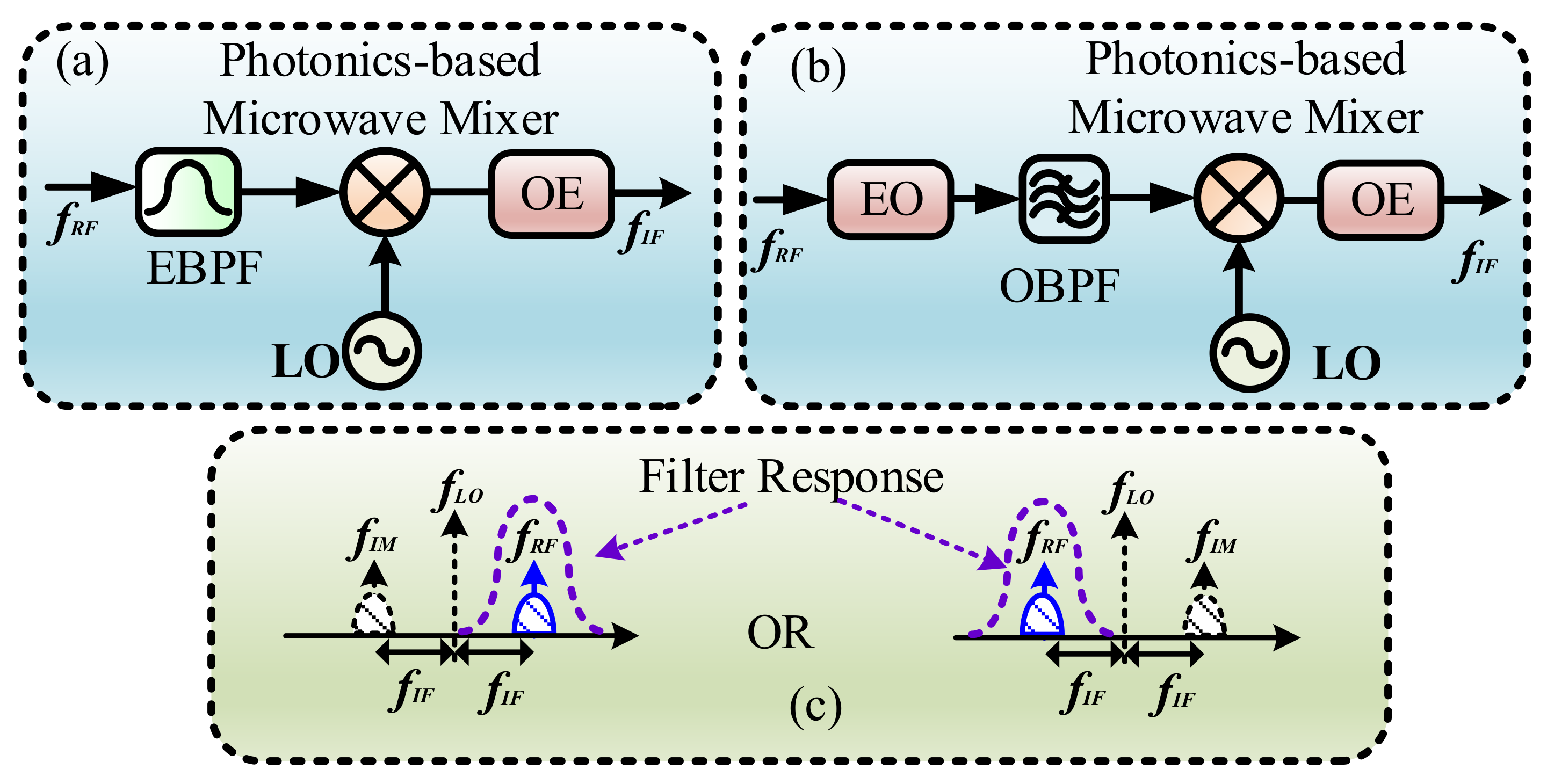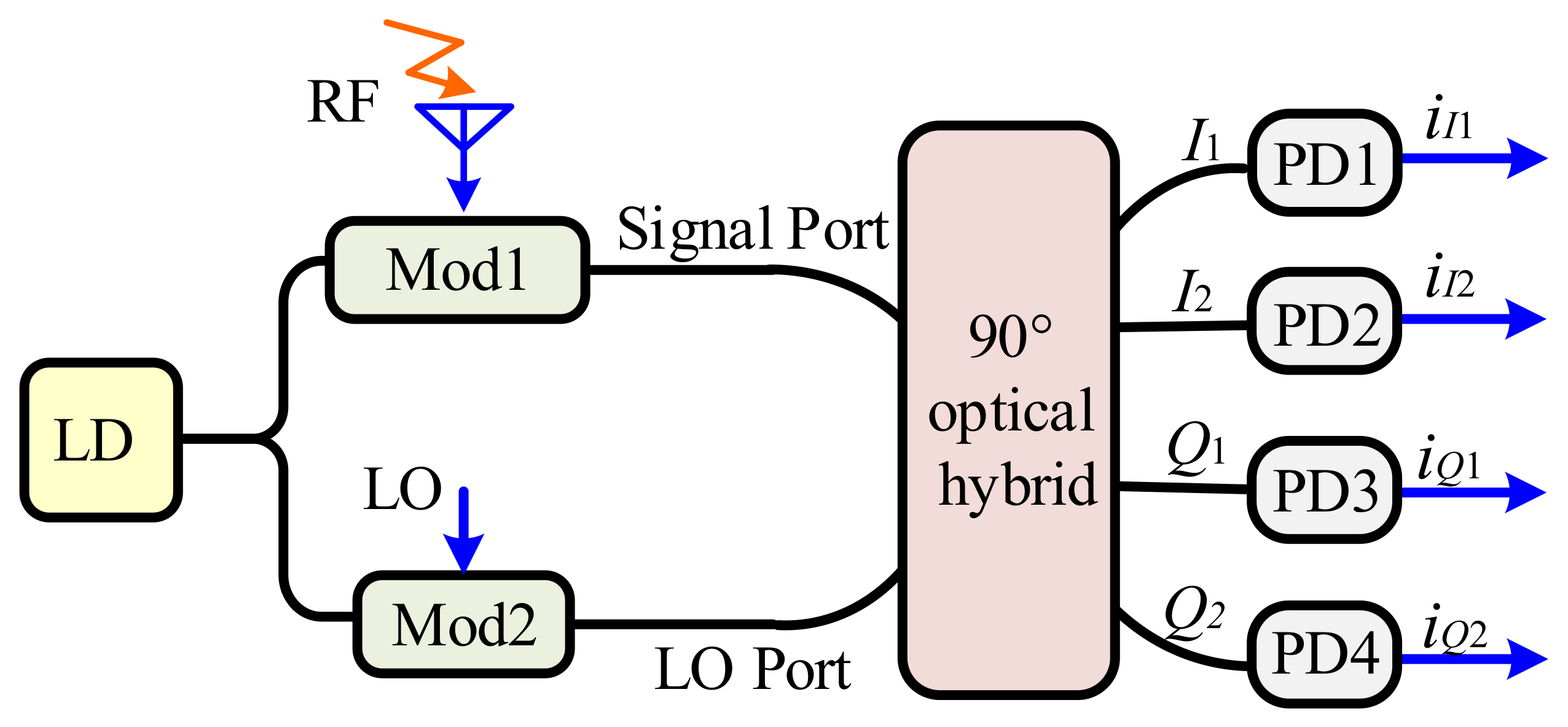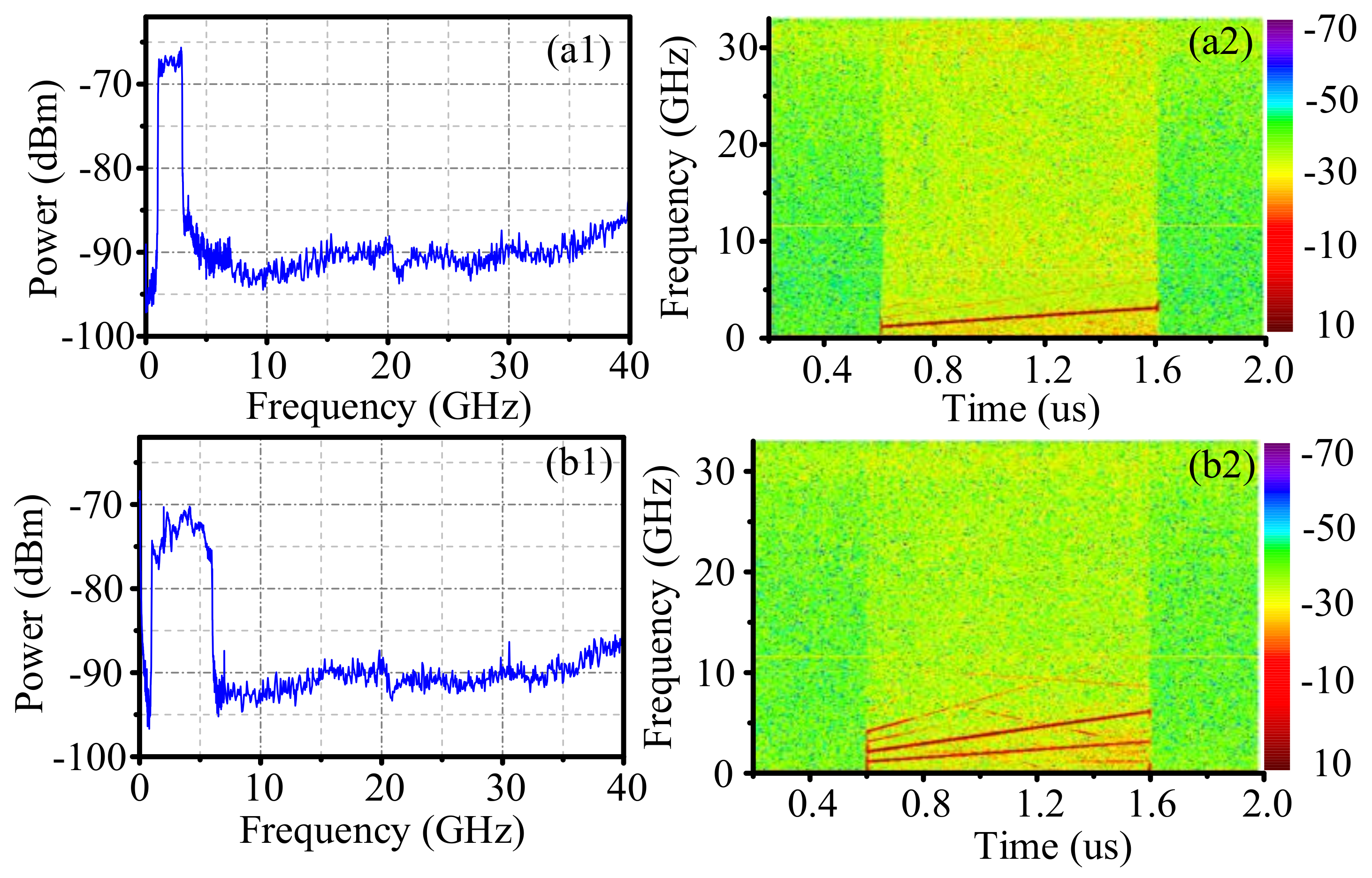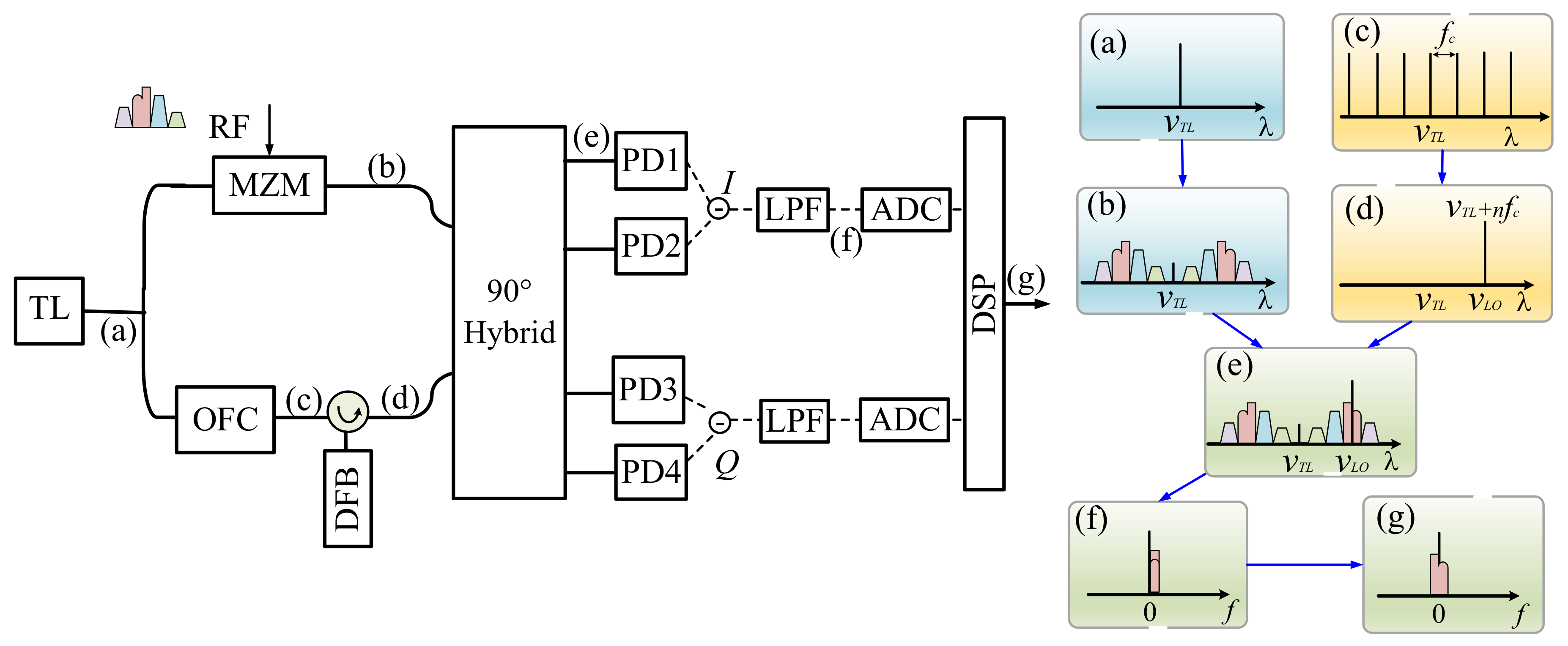Photonics-Based Microwave Image-Reject Mixer
Abstract
:1. Introduction
2. Photonic IRMs Based on Pre-Filtering
3. Photonic IRM Based on Phase-Cancellation Techniques
3.1. Photonic IRMs Based on 90° Electrical Hybrid
3.2. IRMs Based on Microwave Photonic Phase Shifters
3.3. Photonic IRM Based on 90° Optical Hybrid
4. Photonics-Based Microwave IRM Applications
5. Discussions and Conclusions
Acknowledgments
Author Contributions
Conflicts of Interest
References
- Ghelfi, P.; Laghezza, F.; Scotti, F.; Serafino, G.; Capria, A.; Pinna, S.; Onori, D.; Porzi, C.; Scaffardi, M.; Malacarne, A. A fully photonics-based coherent radar system. Nature 2014, 507, 341–345. [Google Scholar] [CrossRef] [PubMed] [Green Version]
- Pan, S.L.; Zhu, D.; Liu, S.F.; Xu, K.; Dai, Y.T.; Wang, T.L.; Liu, J.G.; Zhu, N.H.; Xue, Y.; Liu, N.J. Satellite payloads pay off. IEEE Microw. Mag. 2015, 16, 61–73. [Google Scholar] [CrossRef]
- Ghelfi, P.; Onori, D.; Laghezza, F.; Scotti, F.; Bogoni, A.; Albertoni, A.; Tafuto, A. An RF scanning receiver based on photonics for electronic warfare applications. In Proceedings of the 12th European Radar Conference, Paris, France, 9–11 September 2015; pp. 197–200. [Google Scholar]
- Laghezza, F.; Scotti, F.; Ghelfi, P.; Bogoni, A. Photonics-assisted multiband RF transceiver for wireless communications. J. Lightwave Technol. 2014, 32, 2896–2904. [Google Scholar] [CrossRef]
- Capmany, J.; Novak, D. Microwave photonics combines two worlds. Nat. Photonics 2007, 1, 319–330. [Google Scholar] [CrossRef]
- Yao, J.P. Microwave photonics. J. Lightwave Technol. 2009, 27, 314–335. [Google Scholar] [CrossRef]
- Chan, E.H.W.; Minasian, R.A. Microwave photonic downconverter with high conversion efficiency. J. Lightwave Technol. 2012, 30, 3580–3585. [Google Scholar] [CrossRef]
- Li, P.; Pan, W.; Zou, X.; Lu, B.; Yan, L.; Luo, B. Image-free microwave photonic down-conversion approach for fiber-optic antenna remoting. IEEE J. Quantum Electron. 2017, 53, 9100208. [Google Scholar] [CrossRef]
- Zhu, D.; Liu, S.F.; Pan, S.L. Multi-channel up-conversion based on polarization-modulated optoelectronic oscillator. IEEE Photonics Technol. Lett. 2014, 26, 544–547. [Google Scholar] [CrossRef]
- Cook, J.A.; Henderson, B.C. Image Reject and SSB Mixers; Tech-Note; Watkins-Jonson Co.: Palo Alto, CA, USA, 1985. [Google Scholar]
- IRM (14.0–18.0) GHz. Available online: https://polyphasemicrowave.com/product/image-reject-mixer-14-18-frequency-ghz/ (accessed on 2 February 2017).
- Lindsay, A.C.; Knight, G.A.; Winnall, S.T. Photonic mixers for wide bandwidth RF receiver applications. IEEE Trans. Microw. Theory Tech. 1995, 43, 2311–2317. [Google Scholar] [CrossRef]
- Strutz, S.J.; Williams, K.J. An 8–18-GHz all-optical microwave downconverter with channelization. IEEE Trans. Microw. Theory Tech. 2001, 49, 1992–1995. [Google Scholar] [CrossRef]
- Strutz, S.J.; Williams, K.J. A 0.8–8.8-GHz image rejection microwave photonic downconverter. IEEE Photonics Technol. Lett. 2000, 12, 1376–1378. [Google Scholar] [CrossRef]
- Strutz, S.J.; Biernacki, P.; Nichols, L.; Williams, K.J. Demonstration of a wide-band image rejection microwave downconverter. IEEE Photonics Technol. Lett. 2000, 12, 687–689. [Google Scholar] [CrossRef]
- Strutz, S.J.; Williams, K.J. A 6 to 11 GHz all-optical image rejection microwave downconverter. In Proceedings of the International Topical Meeting on Microwave Photonics, Oxford, UK, 11–13 September 2000; pp. 74–77. [Google Scholar]
- Ward, A.; Nichols, L.T.; Biernacki, P.D.; Williams, K.J. An ultrawideband image rejecting microwave downconverter using WDM. In Proceedings of the International Topical Meeting on Microwave Photonics, Melbourne, Australia, 17–19 November 1999; pp. 239–242. [Google Scholar]
- Lu, C.; Chen, W.; Shiang, J.F. Photonic mixers and image-rejection mixers for optical SCM systems. IEEE Trans. Microw. Theory Tech. 1997, 45, 1478–1480. [Google Scholar] [CrossRef]
- Ogawa, H.; Kamitsuna, H. Fiber optic microwave links using balanced laser harmonic generation, and balanced/image cancellation laser mixing. IEEE Trans. Microw. Theory Tech. 1992, 40, 2278–2284. [Google Scholar] [CrossRef]
- Zhang, J.; Chan, E.H.W.; Wang, X.; Feng, X.; Guan, B. High conversion efficiency photonic microwave mixer with image rejection capability. IEEE Photonics J. 2016, 8, 1–11. [Google Scholar] [CrossRef]
- Tang, Z.Z.; Pan, S.L. Image-reject mixer with large suppression of mixing spurs based on a photonic microwave phase shifter. J. Lightwave Technol. 2016, 34, 4729–4735. [Google Scholar] [CrossRef]
- Gao, Y.; Wen, A.; Chen, W.; Li, X. All-optical, ultra-wideband microwave I/Q mixer and image-reject frequency down-converter. Opt. Lett. 2017, 42, 1105–1108. [Google Scholar] [CrossRef] [PubMed]
- Gao, Y.; Wen, A.; Zhang, W.; Jiang, W.; Ge, J.; Fan, Y. Ultra-wideband photonic microwave I/Q mixer for zero-IF receiver. IEEE Trans. Microw. Theory Tech. 2017, 65, 4513–4525. [Google Scholar] [CrossRef]
- Zhang, W.; Wen, A.; Gao, Y.; Shang, S.; Zheng, H.; He, H. Large bandwidth photonic microwave image rejection mixer with high conversion efficiency. IEEE Photonics J. 2017, 9, 7201908. [Google Scholar] [CrossRef]
- Tang, Z.Z.; Pan, S.L. A Reconfigurable photonic microwave mixer using a 90° optical hybrid. IEEE Trans. Microw. Theory Tech. 2016, 64, 3017–3025. [Google Scholar] [CrossRef]
- Tang, Z.Z.; Pan, S.L. Reconfigurable microwave photonic mixer with minimized path separation and large suppression of mixing spurs. Opt. Lett. 2017, 42, 33–36. [Google Scholar] [CrossRef] [PubMed]
- Pan, S.L.; Tang, Z.Z. A highly reconfigurable photonic microwave frequency mixer. SPIE Newsroom 2015. [Google Scholar] [CrossRef]
- Meng, Z.; Li, J.; Yin, C.; Fan, Y.; Yin, F.; Zhou, Y.; Dai, Y.; Xu, K. Dual-band dechirping LFMCW radar receiver with high image rejection using microwave photonic I/Q mixer. Opt. Express 2017, 25, 22055–22065. [Google Scholar] [CrossRef] [PubMed]
- Li, J.; Xiao, J.; Song, X.; Zheng, Y.; Yin, C.; Lv, Q.; Fan, Y.; Yin, F.; Dai, Y.; Xu, K. Full-band direct-conversion receiver with enhanced port isolation and I/Q phase balance using microwave photonic I/Q mixer. Chin. Opt. Lett. 2017, 15, 66–69. [Google Scholar] [CrossRef]
- Chen, W.J.; Zhu, D.; Pan, S.L. Multi-octave image-reject mixer with large suppression of mixing spurs based on balanced photodetectors. CLEO 2018. submitted. [Google Scholar]
- Tang, Z.Z.; Zhu, D.; Pan, S.L. Coherent RF channelizer based on dual optical frequency combs and image-reject mixers. In Proceedings of the 2017 International Topical Meeting on Microwave Photonics (MWP 2017), Beijing, China, 23–26 October 2017. [Google Scholar]
- Tang, Z.Z.; Zhu, D.; Pan, S.L. A Coherent Optical RF Channelizer with Large Instantaneous Bandwidth and Large in-band Interference Suppression. J. Lightwave Technol. 2018. accepted. [Google Scholar]
- Onori, D.; Scotti, F.; Laghezza, F.; Bogoni, A.; Ghelfi, P.; Bartocci, M.; Zaccaron, A.; Tafuto, A.; Albertoni, A. Relavant field trial of a photonics-based RF scanning receiver for electronic support measures. In Proceedings of the IEEE International Topical Meeting on Microwave Photonics, Long Beach, CA, USA, 31 October–3 November 2016; pp. 65–68. [Google Scholar]
- Onori, D.; Laghezza, F.; Scotti, F.; Bogoni, A.; Ghelfi, P.; Bartocci, M.; Zaccaron, A.; Tafuto, A.; Albertoni, A. A DC offset-free ultra-wideband direct conversion receiver based on photonics. In Proceedings of the 13th European Radar Conference, London, UK, 5–7 October 2016; pp. 374–377. [Google Scholar]
- Zhu, D.; Chen, W.J.; Chen, Z.W.; Du, T.H.; Tang, Z.Z.; Pan, S.L. RF front-end based on microwave photonics. In Proceedings of the 2017 Opto-Electronics and Communications Conference (OECC) and Photonics Global Conference (PGC), Singapore, 31 July–4 August 2017. [Google Scholar]
- Wang, J.; Chen, M.; Liang, Y.; Chen, H.; Yang, S.; Xie, S. Broadband RF front-end using microwave photonics filter. Opt. Express 2015, 23, 839–845. [Google Scholar] [CrossRef] [PubMed]
- Yu, H.; Yu, H.; Wang, J.; Chen, M.; Hoekman, M.; Chen, H.; Leinse, A.; Heideman, R.G.; Mateman, R.; Yang, S.; et al. Photonic-assisted RF frontend operating at U-band and V-band based on Si3N4 ultra-high-Q bandpass filter. In Proceedings of the Optical Fiber Communications Conference and Exhibition 2016 (OFC 2016), Anaheim, CA, USA, 20–24 March 2016. [Google Scholar]
- Clark, T.R.; Waterhouse, R. Photonics for RF front ends. IEEE Microw. Mag. 2011, 12, 87–95. [Google Scholar] [CrossRef]
- Casey, J.A.; Howell, S.E.L.; Tivy, A.; Haas, C. Separability of sea ice types from wide swath C-and L-band synthetic aperture radar imagery acquired during the melt season. Remote Sens. Environ. 2016, 174, 321–328. [Google Scholar] [CrossRef]
- Ghelfi, P.; Laghezza, F.; Scotti, F.; Serafino, G.; Pinna, S.; Onori, D.; Lazzeri, E.; Bogoni, A. Photonics in radar systems: RF integration for state of-the-art functionality. IEEE Microw. Mag. 2015, 16, 74–83. [Google Scholar] [CrossRef]
- Ghelfi, P.; Laghezza, F.; Scotti, F.; Onori, D.; Bogoni, A. Photonics for radars operating on multiple coherent bands. J. Lightwave Technol. 2015, 34, 500–507. [Google Scholar] [CrossRef]
- Emami, H.; Sarkhosh, N. Reconfigurable microwave photonic in-phase and quadrature detector for frequency agile radar. J. Opt. Soc. Am. A 2014, 31, 1320–1325. [Google Scholar] [CrossRef] [PubMed]
- Abari, C.F.; Pedersen, A.T.; Dellwik, E.; Mann, J. Performance evaluation of an all-fiber image-reject homodyne coherent Doppler wind lidar. Atmos. Meas. Tech. 2015, 8, 3729–3752. [Google Scholar] [CrossRef]
- Capmany, J.; Ortega, B.; Pastor, D. A tutorial on microwave photonic filters. J. Lightwave Technol. 2006, 24, 201–229. [Google Scholar] [CrossRef]
- Ortega, B.; Min, R.; Sáez-Rodríguez, D.; Mi, Y.; Nielsen, K.; Bang, O. Bandpass transmission filters based on phase shifted fiber Bragg gratings in microstructured polymer optical fibers. Proc. SPIE 2017, 10232, 1023209. [Google Scholar] [CrossRef]
- Yu, H.; Chen, M.; Guo, Q.; Hoekman, M.; Chen, H.; Leinse, A.; Heideman, R.G.; Mateman, R.; Yang, S.; Xie, S. All-optical full-band RF receiver based on an integrated ultra-high-Q bandpass filter. J. Lightwave Technol. 2016, 34, 701–706. [Google Scholar] [CrossRef]
- Yi, X.; Chew, S.X.; Song, S.; Nguyen, L.; Minasian, R. Integrated microwave photonics for wideband signal processing. Photonics 2017, 4, 46. [Google Scholar] [CrossRef]
- Chen, M.; Yu, H.; Wang, J. Silicon photonics-based signal processing for microwave photonic frontends. In Silicon Photonics III; Topics in Applied Physics; Pavesi, L., Lockwood, D., Eds.; Springer: Berlin/Heidelberg, Germany, 2016. [Google Scholar] [CrossRef]
- Marpaung, D.; Roeloffzen, C.; Heideman, R.; Leinse, A.; Sales, S.; Capmany, J. Integrated microwave photonics. Laser Photonics Rev. 2013, 7, 506–538. [Google Scholar] [CrossRef]
- Pintus, P.; Huang, D.; Zhang, C.; Shoji, Y.; Mizumoto, T.; Bowers, J.E. Microring-based Optical Isolator and Circulator with Integrated Electromagnet for Silicon Photonics. J. Lightwave Technol. 2017, 35, 1429–1437. [Google Scholar] [CrossRef]
- Liu, W.; Li, M.; Guzzon, R.S.; Norberg, E.J.; Parker, J.S.; Lu, M.; Coldren, L.A.; Yao, J.P. A photonic integrated parity-time symmetry wavelength-tunable single-mode microring laser. Nat. Commun. 2017, 10, 190–196. [Google Scholar] [CrossRef]
- Khan, M.H.; Shen, H.; Xuan, Y.; Zhao, L.; Xiao, S.; Leaird, D.E.; Weiner, A.M.; Qi, M. Ultrabroad-bandwidth arbitrary radiofrequency waveform generation with a silicon photonic chip-based spectral shaper. Nat. Photonics 2010, 4, 117–122. [Google Scholar] [CrossRef]
- Urick, V.J.; Mondich, M.J.; Sunderman, C.E.; Kozak, D.A.; Goetz, P.G.; Rabinovich, W.S.; Pruessner, M.W.; Mahon, R.; Williams, K.J. Microwave Phase Shifting Using Coherent Photonic Integrated Circuits. IEEE J. Sel. Top. Quantum Electron. 2016, 22, 6100408. [Google Scholar] [CrossRef]
- Liu, Y.; Choudhary, A.; Marpaung, D.; Eggleton, B.J. Gigahertz optical tuning of an on-chip radio frequency photonic delay line. Optica 2017, 4, 418–423. [Google Scholar] [CrossRef]
- Fandiño, J.S.; Muñoz, P.; Doménech, D.; Capmany, J. A monolithic integrated photonic microwave filter. Nat. Photonics 2016, 11, 124–129. [Google Scholar] [CrossRef]
- Zhang, C.; Zhang, S.; Peters, J.D.; Bowers, J.E. 8 × 8 × 40 Gbps fully integrated silicon photonic network on chip. Optica 2016, 3, 785–786. [Google Scholar] [CrossRef]
- Dai, D.; Bowers, J.E. Silicon-based on-chip multiplexing technologies and devices for Peta-bit optical interconnects. Nanophotonics 2014, 3, 283–311. [Google Scholar] [CrossRef]
- Liu, W.; Li, M.; Guzzon, R.S.; Norberg, E.J.; Parker, J.S.; Lu, M.; Coldren, L.A.; Yao, J.P. A fully reconfigurable photonic integrated signal processor. Nat. Photonics 2016, 10, 190–195. [Google Scholar] [CrossRef]
- Xue, X.; Leo, F.; Xuan, Y.; Jaramillo-Villegas, J.A.; Wang, P.-H.; Leaird, D.E.; Erkintalo, M.; Qi, M.; Weiner, A.M. Second-harmonic-assisted four-wave mixing in chip-based microresonator frequency comb generation. Light Sci. Appl. 2017, 6, e16253. [Google Scholar] [CrossRef]
- Capmany, J.; Doménech, D.; Muñoz, P. Graphene Integrated Microwave Photonics. J. Lightwave Technol. 2014, 32, 3785–3796. [Google Scholar] [CrossRef]










© 2018 by the authors. Licensee MDPI, Basel, Switzerland. This article is an open access article distributed under the terms and conditions of the Creative Commons Attribution (CC BY) license (http://creativecommons.org/licenses/by/4.0/).
Share and Cite
Zhu, D.; Pan, S. Photonics-Based Microwave Image-Reject Mixer. Photonics 2018, 5, 6. https://doi.org/10.3390/photonics5020006
Zhu D, Pan S. Photonics-Based Microwave Image-Reject Mixer. Photonics. 2018; 5(2):6. https://doi.org/10.3390/photonics5020006
Chicago/Turabian StyleZhu, Dan, and Shilong Pan. 2018. "Photonics-Based Microwave Image-Reject Mixer" Photonics 5, no. 2: 6. https://doi.org/10.3390/photonics5020006




